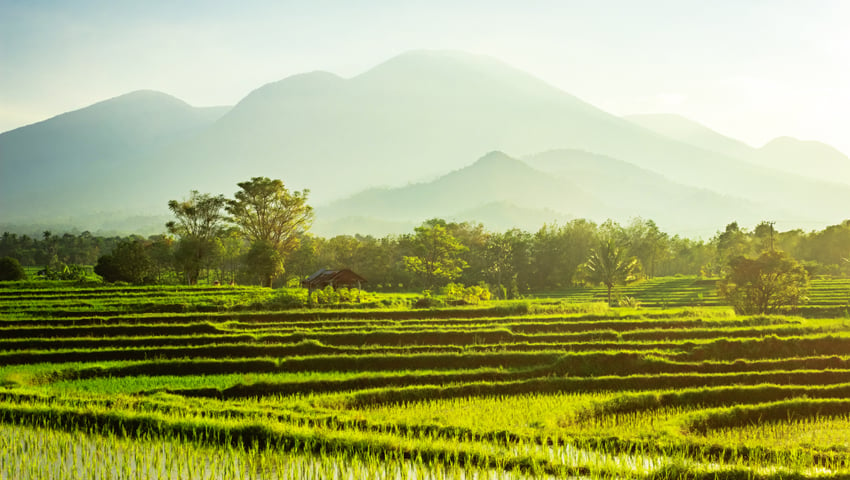THE WORLD’S thirstiest crop is also responsible for feeding half our planet. The Sustainable Rice Platform thinks it can make a better life for farmers and consumers alike, writes Kannikar Petchkaew on the Food Planet Prize website.
Rice requires up to 2,500 litres of water per kilogram – twice the amount needed for wheat and five times that for maize.
Ms Petchkaew says that up to one-third of the world’s developed freshwater resource goes to irrigate rice, but rice farmers are noticing that with much less rain they are being forced to farm with barely enough water.
Now, the Sustainable Rice Platform (SRP) has become the cutting-edge play book for creating more sustainable, drought-resistant and higher-quality rice crops.
The SRP was founded in 2011 by the IRRI and the United Nations Environment Programme. With over 100 research and private sector partners the SRP is the world’s first rice standard.
Wyn Ellis, Executive Director of SRP, says that there have been longstanding efforts to make perceived high-value crops like coffee or cotton more sustainable. “Rice, on the other hand, is considered substantially less sophisticated, and so it’s overlooked despite a larger carbon footprint,” he says. The danger of that oversight can go in two directions, he says. Rice can harm the planet while itself “becoming a victim” of global warming.
One hectare of rice crop, if farmed with constant flooding and chemical fertilizers, can also emit up to 300kg of methane. The Sustainable Rice Platform aims to reform the global rice sector to help improve the planet, the product, and the people who farm it. But to do this, the rice value chain had to be redesigned from beginning to end.
The SRP standard covers eight areas and is split into 41 separate indicators. Farmers are advised on everything from farm management and pre-planting to water use, nutrient management, and integrated pest management. Best practices, such as including drying time in post-harvest (which has been shown to ensure the highest quality grain), are encouraged.
Ms Petchkaew writes that Thanu Thanhakij, who oversees nearly 150 rice farmers in his role at the Ban Don Mu Community Rice Center in Ubon Ratchathani, adopted the SRP standard in 2018 to astonishing results. “Only direct seeding, rather than sowing over the field as in the past, saved us 80% of what we paid for seed,” Thanu explains. “We saved 60% off the overall cost. Rather than flooding the field for an entire month, alternate watering and drying saved us 50% of the water and yielded more rich grain. Land studies enable us to have custom-made fertilizers and determine how much we need. There’s no reason to waste money on fertilizer we don’t understand. We now have cash left in our pockets.”
SRP has 506 SRP-verified trainers working with over 150,000 farmers in 39 countries. In 2022 alone, SRP verified just under 130,000 tons of paddy rice from more than 30,000 hectares in India, Pakistan, Thailand, Vietnam, Myanmar, and Spain. This year, Ellis and his colleagues intend to double all those numbers. Only rice that meets the highest level of “the SRP Assurance Scheme” can leave the nation of origin as SRP-verified rice.
Developed in 2020, the SRP Assurance Scheme comprises three degrees of assurance based on different evaluation demands and levels of robustness. Rice farmers and farmer organizations can select between self-assessment at Level 1 and second-party verification at Level 2.
Those who passed Level 3 audits conducted by independent third-party auditors are allowed to use the SRP label on their products. SRP-Verified rice is now accessible on retail shelves in 20 countries, including Denmark, the United Kingdom, Germany, Italy, and Switzerland. SRP’s marketing team in Europe works closely with food retailers and organizations, including Lidl, Costco, and Walmart, to put SRP rice on shelves.
Next year, SRP and a host of partners will launch rice farmer finance operations in Bangladesh, Cambodia, and Vietnam. Their mix of policy and market-oriented solutions has been successful wherever they have expanded.
In 2019, the Sustainable Rice Landscapes Initiative used the SRP as its “replicable and scalable” tool to help them measure and manage 4.2 million hectares in South and Southeast Asia to reduce 116.2 million tons of greenhouse gas emissions.
